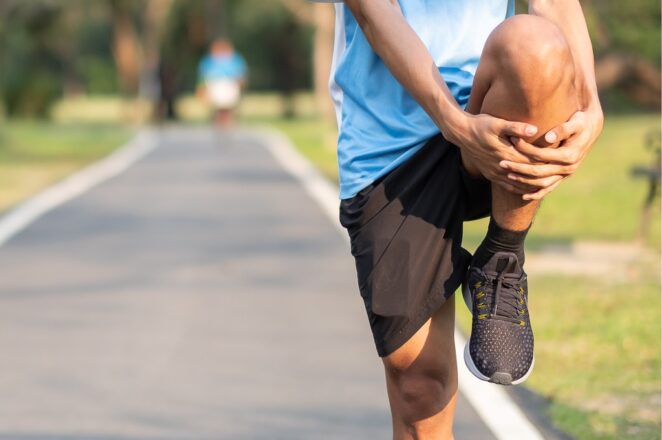Pain in your leg or hip? Maybe it’s sharp. Or maybe it’s a dull ache that comes with a burning sensation and mild tingling.
Either way, sciatic nerve pain can be distressing. It can interfere with your daily life and keep you from running or exercising as usual.
Mild sciatica often goes away on its own with rest, cold packs, and anti-inflammatory medications. Specific stretches for sciatica can also help.
Read on to discover some of the best sciatic nerve pain relief stretches you can do at home. But first, let’s understand what causes this type of pain.
In This Article:
What Is the Sciatic Nerve?
The sciatic nerve is a bundle of 5 spinal nerve roots. It is the longest and thickest nerve in the body, running from the lower back through the buttocks and down the legs. Below the knee, it branches into other nerves that run down to the toes.
The sciatic nerve helps move the muscles in your legs and feet. It also helps provide sensation in your legs. Unfortunately, this also means that it can sometimes cause pain.
What Causes Sciatic Nerve Pain?
Sciatic nerve pain causes radiating leg pain along the length of the sciatic nerve. This condition is known as sciatica.
Sciatica occurs when there is a problem along the path of the nerve. Common culprits include a slipped or ruptured intervertebral disc (herniated disc).
Intervertebral discs are jelly-like cushions that sit between vertebrae in the spine. They prevent the vertebrae from rubbing against each other when the body moves.
A herniated disc typically occurs between the lumbar vertebrae and the sacrum. Pain that radiates from the buttock down to the sciatic nerve is associated with disc disease 85% of the time.
Weight lifting and other exercises that put pressure on your spine, back, and legs can cause sciatic nerve pain.
Spinal stenosis can also cause problems with the sciatic nerve. This is a narrowing of the spinal canal that can occur due to arthritis.
Another condition that can cause this type of pain is piriformis syndrome. This involves the piriformis muscle, which runs from your buttocks to the top of your thigh.
Sciatica may occur because of pregnancy, too. Hormonal changes during pregnancy relax the ligaments and make the body’s center of gravity shift.
As a result, the sciatic nerve itself can shift and become pinched. This is why pregnant women may experience shooting pains down their buttocks and legs.
Common risk factors for sciatica:
- Age. As people age, some develop herniated discs or bone spurs. These can pinch the sciatic nerve.
- Occupation. Carrying heavy objects or driving for long periods can increase the risk of sciatica.
- Weight. Being overweight puts more pressure on the spine and can lead to sciatic nerve problems.
- Sitting for long periods. Sitting for hours at a time increases pressure on the disc. Over time, this can lead to herniated discs.
- Smoking. A 2016 meta-analysis of multiple studies found that smoking increases the risk of lumbar pain and sciatica.
The good news is that many sciatica risk factors, such as being overweight and smoking, can be modified.
Next, let’s look at how to stretch the sciatic nerve.
Stretches for Sciatica Pain Relief
Around 20–30% of people who develop acute sciatica may continue to have pain several years later. Stretches that rotate your hip outward can help relieve both acute and chronic sciatica.
You should also do exercises that loosen and strengthen your lower back muscles, hamstrings, and abdominal muscles.
It’s good to do these exercises twice a week or more often if it feels good.
It’s important to take deep breaths while performing these exercises. Breathe in and out naturally as you do the movements. Feel the air moving through your abdomen – avoid shallow chest breathing.
By paying attention to your breathing, these stretches can double as a form of meditation.
So what are the best sciatic nerve stretches you can do at home?
Glute bridge
The glute bridge is one of the best lower back sciatica stretches. It strengthens your glutes and supports lower back health. It also strengthens your core.
1. Lie on your back on the mat with your knees bent.
2. Place your feet hip-wide flat on the floor.
3. Hold arms out to sides with palms down.
4. Engage your core.
5. Push through your heels to raise your hips and squeeze your glutes.
6. Hold for 10–30 seconds. Your body should be straight from head to knees.
7. Slowly lower your body to the floor to complete one repetition.
8. Perform 8–10 reps.
Knees to chest
Increase spinal flexion and relieve sciatica with this simple exercise.
1. Lie on your back on the floor.
2. Straighten your legs without arching your back.
3. With a slow and controlled movement, bring one knee toward your chest and grasp it behind the knee.
4. Gently pull the knee. You should feel the stretch in your lower spine and hip.
5. Hold for 10–30 seconds.
6. Return to the starting position to complete one rep.
7. Perform 8–10 reps.
Clamshell
This exercise engages the hips. It strengthens the main rotator muscle of the hip, the gluteus medius.
1. Lie on your right side with your right arm under your head. Both knees should be bent.
2. Tense your abdominal muscles.
3. Raise your upper knee. Be sure to keep your feet together during this movement.
4. Open your legs like a clamshell.
5. If necessary, support yourself with your upper arm.
6. Hold the position for 10–30 seconds.
7. Return to the starting position to complete one rep.
8. Perform 8–10 reps.
Cobra or modified cobra
This exercise stretches your spine. It can relieve pressure on the sciatic nerve caused by a herniated disc.
1. Lie on your stomach with your legs together.
2. Place your palms on your chest and flex your elbows.
3. Fully extend your elbows and raise your chest off the floor as high as possible.
4. Hold this position for 10 seconds before returning to the starting position to complete one rep.
5. Perform 10 reps.
Note: If you find the cobra exercise too difficult, you can start with the modified cobra. To do this, partially extend your elbows until your chest is about 45 degrees off the ground.
Side-to-side knee stretch
This exercise gently rotates your lumbar spine. It’s one of the easiest and most effective stretches for the pinched sciatic nerve.
1. Lie on your back with your knees bent and feet flat on the floor.
2. Extend your right arm. It should be level with your shoulder.
3. Move both knees to the left as far as possible.
4. Hold for 30 seconds.
5. Return to the starting position.
6. Extend your left arm and rotate to the right, repeating the motion on the other side.
Supine hamstring stretch
This exercise works your hamstrings and lower back muscles. You will need a towel or an exercise belt.
1. Lie on your back on the mat.
2. Raise your right foot and wrap a towel or belt under the arch of your foot.
3. Bend the other knee and place your foot on the floor.
4. Pull and lift your right foot toward the ceiling while holding the ends of the belt. Make sure your leg is straight, and your back is flat on the floor.
5. Hold for 30 seconds.
6. Lower leg and repeat with left leg.
When to See a Doctor for Sciatica
Sciatic nerve stretches can help relieve and prevent pain. However, even if your sciatica is mild, you should talk to a doctor before doing any stretches.
This is especially important if you plan to do sciatica stretches for more than a month.
You may also want to see a doctor for sciatica if you experience:
- Severe pain
- Numbness
- Weakness
- Changes in bowel or bladder function
- Signs of infection like fever, chills, and night sweats
- Sciatica pain that lasts more than 6 weeks
Exercise With Care
Stretching for sciatica should not increase your pain or discomfort. If you experience increased pain while stretching, stop immediately and consult your doctor.
It’s also important to understand that the best stretches for sciatica vary from person to person. Some people may find some exercises easier and more beneficial than others.
Try them all, vary your stretching routine, and see how your body responds. Don’t expect to have the same flexibility as people doing these exercises in online videos.
Do the exercises gently, and don’t push yourself too hard.
Also, avoid sitting or lying down for too long. When lifting heavy objects, lift with your knees, not your back. This can help prevent the worsening of sciatic nerve pain.














